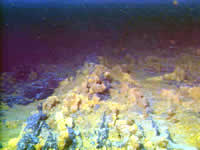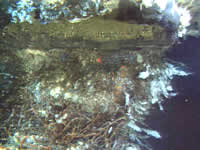| |
Teacher Logbook - NOAA Ship Ron Brown
| |

Iron oxide "cabbage patch type"
mounds at FeHyde vent, southern ASHES vent field.

This is a "flange pool" where
hot buoyant vent fluid is trapped beneath a part of the sulfide chimney
that is protuding outward (toward the camera). The bottom surface
of the hot fluid looks like a horizontal mirrored surface because
its properties are dramatically different from the surrounding seawater.
|
|
Jeff Goodrich's Sealog:
Axial Volcano: Western part of caldera at ASHES vent field
July 22, 2001
297, 298,
299, 299.9 degrees Celsius.......(a quiet pause)....... We just couldn't
break 300. A hydrothermal playground, the ASHES vent field has black smokers,
diffuse vents, tube worms, and everything else that excites scientists
about these submarine hot springs. Looking at the monitor I asked, "What
are all those orangish mounds?" "Talk to Chris Kennedy. He's
the Iron-oxide guy" someone exclaimed. A few minutes later Chris
entered the hydro lab and gave me the rundown on what they were. Here's
what he had to say.......
Iron oxide
deposits are found extensively at Mid Ocean Ridges (MOR) around the globe
including Axial Volcano. On the sea floor they look like "cabbage
patches" or "blankets" covering large areas (100's of meters2)
near low temperature diffuse vents. What makes them unique and interesting
is the large component of iron oxidizing bacteria within them that holds
many possibilities for understanding past environmental conditions on
Earth, and may serve as evidence for life on other planets. The composition
and structure of these deposits may also contribute to the regulation
of trace elements in the oceans and may be an excellent material to aid
in remediation of polluted terrestrial watersheds. The structure of a
bacterial cell wall is intrinsically negatively charged and able to attract
a variety of positive ions such as iron. In some ways it's similar to
seeding a cloud for rain. Normally, soft-bodied organisms degrade quickly
after death. In this case the bacteria's morphology is preserved by an
"encasing" of iron. Vent bacteria are likely increasing the
rate of iron mineralization in the oceans.
Bacteria
similar to those seen here at Axial Volcano, have been noted in
ancient
terrestrial deposits. It is entirely possible that these mineralized
bacteria
are surviving the test of geologic time by becoming fossils. By discovering
bacterial fossils on land, many inferences to past environmental conditions
(paleoenvironments) can be made. Bacterial fossils may not be restricted
to
Earth. There is increasing evidence of iron oxides on Mars that may harbor
bacterial fossils. Early Mars may have had similar MOR geologic activity
to
that seen here today on Earth. Evidence is also mounting for geologic
activity
on Jupiter's moon Europa, which may provide a favorable environment for
iron
oxidizers.
Sea floor
iron oxides, which have been identified as the iron oxide phase ferrihydrite
[Fe(OOH) or Fe(OH3)], may play a significant role in the cycling
of trace elements in the world's oceans. Mid-ocean ridges form a planetary
"seam" extending approximately 80,000 km around the globe, with
ferrihydrite
likely present over much of the area. The combination of the large surface
area
of ferrihydrite, its chemical structure and composition, provides it with
the
ability to adsorb (i.e. "suck up") many trace elements to concentrations
much
higher than normal seawater. Understanding how ferrihydrite is able to
"suck
up"
metals makes it a useful agent in potentially cleaning up polluted
watersheds,
acting locally as the "paper towel" of the vent systems and
global oceans.
|
|

